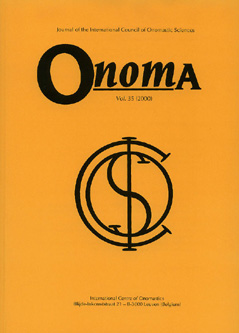 previous article in this issue previous article in this issue | next article in this issue  |

Preview first page |
Document Details : Title: The Toponymic Status of Zulu School and Shop Names Author(s): KOOPMAN, Adrian Journal: Onoma Volume: 44 Date: 2009 Pages: 55-67 DOI: 10.2143/ONO.44.0.2143401 Abstract : Schools and shops occupy specific places in a landscape, so the names of schools and shops should indeed be regarded as ‘place names’, or ‘toponyms’. On the other hand, shops and schools are also institutions – organizations consisting of staff and customers, with certain goods for sale, and a particular history and ethos. In most cases, when one hears the name of a particular school or shop, one thinks immediately of its character as an institution, rather than its precise location. A comparative study of the Zulu names of schools and shops on the one hand, and the names of geographical features like mountains and rivers on the other hand, show that schools and shops share distinctive semantic features which are seldom if ever found among the names of geographical features. While it is accepted that the primary function of any name is to identify (the referential function), and that the primary meaning of any name is likewise a referential meaning, the secondary functions of the three named identities (schools, shops, and geographical features) and the secondary meanings that go with them, show quite distinctive and different patterns. The names of geographical features seldom have any secondary function, and where underlying meanings can be found, these are usually descriptive of the feature itself, and so emphasise the referential function of the name. On the other hand the secondary function of school and shop names is very distinctly a marketing function: the name sends a message to potential customers: 'Attend this school! Buy at this shop!' The paper concludes by looking at the importance of message-sending in Zulu names generally, and how important this is in the naming of people and animals. Les écoles et les magasins occupent des endroits spécifiques dans un paysage, leurs noms devraient donc être effectivement considérés comme des noms de lieux ou toponymes. D’autre part, les magasins et les écoles sont aussi des institutions – les organismes se composant du personnel et des clients, avec certaines marchandises pour la vente, une histoire particulière et une philosophie. Dans la plupart des cas, quand on entend le nom d’une école particulière ou d’un magasin, on pense immédiatement à son caractère d’institution, plutôt qu’à sa localisation précise. Une étude comparative des noms zoulous d’écoles et de magasins d’une part et des noms de caractéristiques géographiques comme les montagnes et les fleuves d’autre part, montre que les écoles et les magasins partagent des traits sémantiques distinctifs qui figurent rarement ou jamais parmi les noms de caractéristiques géographiques. Quand il est admis que la fonction primaire de n’importe quel nom est d’identifier (la fonction référentielle) et que le sens primaire de n’importe quel nom est aussi un sens référentiel, les fonctions secondaires des trois identités désignées (écoles, magasins et caractéristiques géographiques) et les sens secondaires afférents révèlent des profils tout à fait distinctifs et différents. Les noms de caractéristiques géographiques ont rarement une fonction secondaire et, quand des sens sous-jacents peuvent être trouvés, ils sont généralement descriptifs de la fonction elle-même, ce qui met ainsi l’accent sur la fonction référentielle du nom. D’autre part, la fonction secondaire des noms des écoles et des magasins est très distinctement une fonction de marketing: le nom envoie un message aux clients potentiels: 'Fréquentez cette école! Achetez dans ce magasin!'. L’article s’achève en étudiant l’importance de transmettre un message par l’usage des noms zoulous en général, et d’appeler ainsi les personnes et les animaux. Schulen und Geschäfte besetzen spezifische Plätze in einer Landschaft; daher sollten Namen von Schulen und Geschäften ebenfalls als 'Ortsnamen' oder 'Toponyme' betrachtet werden. Andererseits sind Schulen und Läden auch Institutionen – Organisationen, die aus Belegschaft und Kundschaft bestehen, bestimmte Waren verkaufen und eine besondere Geschichte und Ethos besitzen. Wenn man den Namen einer bestimmten Schule oder eines bestimmten Geschäftes hört, denkt man in den meisten Fällen unverzüglich eher an ihren Charakter als Institution als an ihre genaue Lage. Eine komparative Studie über Namen von Schulen und Geschäften bei den Zulu auf der einen Seite und der Namen geografischer Merkmale wie Berge und Flüsse auf der anderen Seite zeigen, dass Schulen und Geschäfte charakteristische semantische Merkmale gemeinsam haben, welche sich in den seltensten Fällen bei Bezeichnungen geografischer Charakteristika finden. Während es gemeinhin akzeptiert wird, dass die hauptsächliche Funktion von Namen in der Kennzeichnung besteht (die referentielle Funktion), und dass die Hauptbedeutung jeglichen Namens ebenso eine referentielle Bedeutung ist, zeigen die Nebenfunktionen der drei genannten Größen (Schulen, Läden und geografische Charakteristika) und die Nebenbedeutungen, die mit diesen einhergehen, markante und unterschiedliche Muster. Die Bezeichnungen geografischer Merkmale haben selten Nebenfunktionen, und wenn ihnen zugrundeliegende Bedeutungen nachgewiesen werden können, beschreiben diese normalerweise das Merkmal an sich und unterstreichen so die referentielle Funktion eines Namens. Andererseits handelt es sich bei der Nebenfunktion von Namen von Schulen und Geschäften merklich um eine Marketing funktion: die Bezeichnung sendet eine Botschaft an potentielle Kunden: 'Besuchen Sie diese Schule! Kaufen Sie in diesem Geschäft!' Das Paper schließt mit einem Blick auf das Gewicht von Botschaften in Bezeichnungen bei den Zulu im Allgemeinen und deren Rolle bei der Bennennung von Menschen und Tieren. |
|


